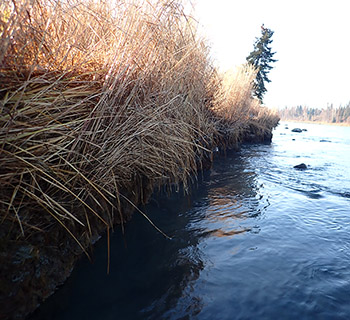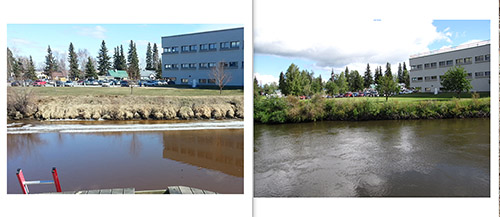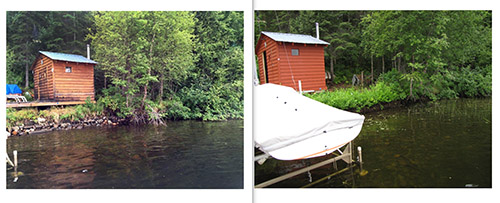Alaska Fish & Wildlife News
May 2021
Protecting and Improving Fish Habitat
The Cost-Share Program

Many Alaskans who own property along rivers, streams, and lakes enjoy convenient access to fishing and boating along with the beautiful scenic views only available in Alaska. For anyone living along a waterbody, one of the biggest headaches is the threat of erosion and the loss of their property. Erosion can be a naturally occurring process or caused by human activities. Often, many landowners are unaware that their own actions are contributing to the loss of their property or having a tremendous impact to the health of the waterbody and its wildlife.
Erosion is greatly accelerated when vegetation is removed along a streambank to establish unhindered views or green lawns to the water’s edge, or when streambanks are trampled and compressed in the creation of social trails to access the water. These actions lead to the destabilization of the bank. Unfortunately, in many instances landowners will try to resolve the issue by installing riprap or bulkheads, leading to additional erosional issues downstream and neither solution provides habitat to rearing juvenile salmon. Since this is such an important issue, the Alaska Department of Fish and Game (ADF&G) has a Streambank Rehabilitation and Restoration Program, commonly known as the Cost-Share Program, that helps Alaskans maintain and protect healthy riparian corridors along their streambanks. This is a partnership between private landowners and public land managers that helps to stabilize and rehabilitate streambanks using fish-friendly techniques to maintain access, while protecting water quality and fish and wildlife habitat.
The Cost-Share Program got its start in 1995 when ADF&G partnered with the U.S. Fish and Wildlife Service (USFWS) to start implementing rehabilitation projects on private land and public lands and hosting Streambank Rehabilitation and Education Workshops on the Kenai Peninsula. The Cost-Share Program was so successful that it was expanded to include projects in the Mat-Su Valley in 2007 and the Fairbanks area in 2008. To date, the Cost-Share Program has installed 857 projects statewide.
The overarching goal of the Cost-Share Program is to sustain and improve fish habitat. There are several objectives that help the program reach the goal: removing harmful structures such as jetties, bulkheads, and riprap from waterbodies; maintaining and protecting healthy riparian corridors and fish habitat; and stabilizing and rehabilitating habitat that has already been damaged.
The Important Riparian Corridor
Riparian corridors include the streambank, floodplain, and a distinct riparian vegetation which transitions into upland vegetation as the land rises away from the river. The width of the riparian corridor is determined by size of the river and the surrounding terrain and can vary from tens of feet to many miles, often encompassing side channels, wetlands, and oxbow lakes. Riparian corridors are more productive than the surrounding lands due to the availability of moisture and nutrients, with an abundance of vegetation and animal life. The increased productivity of the riparian area also benefits fish because nutrients from the highly productive riparian corridor are the basis of the food chain in most river systems. Other functions provided by riparian corridors include moderating stream temperatures, filtering sediment and pollutants from surface runoff, slowing flood waters, buffering storm runoff, and reducing peak flows during rain events.

“Most landowner don’t understand that removing the natural vegetation from the riparian corridor and streambanks not only accelerates the rate of erosion, but it also decreases rearing habitat and the survival of juvenile salmon,” said Fish and Game Habitat Biologist Michael Mazzacavallo.
The removal of riparian vegetation has a negative effect on the riparian corridor. Plant roots help bond soil particles together and hold the soil in place, like rebar holding and strengthening concrete, and prevent or slow erosion of the banks during high flows and during rainstorms. In addition, vegetation adds roughness to the banks and floodplain, which slows water velocity during floods, reducing its power to erode. Slowing flows causes depositions of suspended fine sediment particles in the water column (silt and sand) on the floodplain surface thereby adding nutrients to the soil, growing, and strengthening the streambank. Human activities that can accelerate erosion include removing riparian vegetation through direct cutting or trampling including submerged vegetation, altering drainage patterns from adjacent areas, increasing the intensity and frequency of runoff events, parking boats along banks, and creating waves and wakes generated from watercraft.
When a riparian corridor is impacted or eliminated there are several negative effects on streams and rivers. Flood flows increase and become more destructive because the water is not retained by wetlands or slowed by vegetation in the floodplain. Sediment and pollutants enter the river and impact water quality, fish, and other aquatic life. Fewer terrestrial insects will fall into the stream, decreasing the availability of food for fish. Also, populations of wildlife associated with riparian corridors, such as birds, bears, beavers, and otters diminish.
Fairbanks North Star Borough Building
In 2013, Festival Fairbanks, and organization that plans and facilitates various projects related to historic old Fairbanks and Interior Alaska, beautification, tourism, and economic development, approached both the Fairbanks North Star Borough and the Cost-Share Program about rehabilitating the streambank in front of the Fairbanks North Star Borough building in downtown Fairbanks. The only vegetation along the bank was non-native lawn grass and stormwater runoff was eroding small gullies along the bank. Working with Festival Fairbanks and the Cost-Share Program, the Fairbanks North Star Borough installed rootwads, willows, and a vegetive mat that included other native vegetation to rehabilitate the site. These techniques help slow the rate of erosion and provide juvenile salmon with shelter, shade, and a source of food.
The Nancy Lake Cabin

A landowner with a cabin on Nancy Lake was having erosion issues not from cutting their vegetation, but from boat wakes. They placed rocks and cinder blocks along the bank to help harden the bank and prevent erosion. Using rock to stabilize banks was a common technique that we now know is detrimental to rearing juvenile salmon. In this case the rocks and cinder blocks were also not helping to slow or stop the erosion and were preventing natural revegetation of the banks. The landowner approached ADF&G about doing a stabilization project on their property after seeing other projects completed on Nancy Lake. The resulting project moved a wooden deck and a shed back from the water’s edge, planted willows and other native vegetation, and installed elevated, light penetrating walkways so that the landowners could still access the lake easily while allowing revegetation of the shoreline and protecting the shoreline from boat wakes.
Habitat Rehabilitation Workshops
ADF&G teaches a two-day Streambank Rehabilitation Workshop that is offered at no charge to an audience that includes landowners, agencies, non-profit organizations, consultants, contractors, students, and others. The first day of the workshop provides education on fish habitat, hydrology, plant materials, construction materials, and construction techniques for streambank rehabilitation projects. The second day of the workshop involves the hands-on installation of a rehabilitation project by workshop participants. Workshop participants are introduced to a supportive network of restoration professionals who are available for further consultation and they learn how to avoid or minimize impacts to salmon rearing habitat.
If you, or anyone you know, is interested in attending the Streambank Rehabilitation Workshop or getting assistance with your streambank stabilization project please contact the Cost-Share Program at dfg.dsf.streambankrehab@alaska.gov.
“One thing that all landowners should remember is that while we can revegetate and rehabilitate streambanks and lakeshores, we cannot restore them to their original condition. The advice I would give to landowners is to try and minimize or not disturb the riparian corridor at all so that the riparian corridor can function properly,” said Michael Mazzacavallo.
Jessica Johnson is a Habitat Biologist with the Alaska Dept of Fish and Game, Division of Sport Fish. She is the lead for the Cost-Share Program at Fish and Game and can be reached at (907) 267-2403 or dfg.dsf.streambankrehab@alaska.gov.
Subscribe to be notified about new issues
Receive a monthly notice about new issues and articles.
